TimberSurf’s Model Railway
Modelling Tips, Links & Guides for Model Railways

Lumsdonia Railway

A web page for my indulgence and sharing ideas and irregular updates on my Model railway






SALE
PLUS
How do you decide what soldering iron to use/buy
Soldering Iron Guide
Soldering
Which soldering iron? Cheap or expensive? Soldering station or soldering iron?
There are a few factors to choose from, temperature control, tip and power.
Power is usually ranges from 25W to 120W. Temperature control can take the form of :- none, bimetallic strip, PTC, magnetic (Curie point) or thermocouple.
So let's analyse what they are:-
None - Cheap soldering irons, have no temperature control. Temperature is (fixed) high and results in the tip to burning out very quickly. (usually fitted with only one tip size, but sometimes alternate tips available) [25-120W]
Bimetallic - Quite rare now, but essentially temperature controlled by a heat sensitive switch in the iron body. Better than none, but still very crude. (usually fitted with only one tip size, but sometimes alternate tips available) Very wide hysteresis. [25-40W]
Magnetic - Uses the (MagneStat) Curie Point to control the temperature by means of switching when magnetism is reduced by temperature. Available in iron and station, small hysteresis of set point, selected by 3 types of tip (600F, 700F or 800F). There is a wide range of tip sizes/shapes. [60-80W]
PTC and thermocouple - Essentially the same, they have a sensor in the tip that is wired back to the station to give feedback for the temperature control. They are variable temperature (knob or buttons with readout). A limited range of tips are available. Hysteresis is very tight. [25-60W]
So soldering station or soldering iron? What's the difference?
Soldering irons as seen from above are either fixed or temperature controlled, they can be very high power (240W is available), they are 230V mains powered so have a 3 core flex (thick and stiff) and although the tip is earthed, may not be ESD friendly!
Soldering stations can drive magnetic or are sensor temperature controlled. They are low voltage, usually 24v (at the iron). Max power is about 80W. They can have 2 wire (magnetic) or 3/4 wire cord, usually smaller and more flexible (silicon) than mains cord (as extra thick insulation for protection from mains is not required). The tip is 'isolated', so is ESD friendly. The disadvantage is portability, they are really designed for the bench.
Alternatives
There are other options! Gas powered soldering irons have adjustable power (not temperature controlled), they have massive power output and as well as soldering, have some great tips offering some interesting uses (pyrography, plastic rope cutting/sealing, heat gun, poly knife and blow torch). The main advantage is portability (no mains needed, freedom of no flex), intended for site use, but useful under the layout. Disadvantage is having to buy/fill with gas.
Battery (rechargeable) soldering irons are also available (I had one 20 years ago), but offer little power (6W!) and have a very short life before needing recharging. No control over power or temperature. Pretty much just for quick site work, advantage over gas is there is no naked flame. I would definitely not recommend them.
Soldering guns have been around for ages, pull the trigger to heat, let go and it switches off. Very powerful and quick to heat up when required, they are heavy, bulky and clumsy. Great if you need lots of heat but with intermittent use.
Hot air gun, no not the wife's hairdryer, designed for non contact soldering of SMD components, good for tiny joints, not much use for anything else (bigger nozzles can be used, but collateral damage becomes an issue).
Resistance soldering uses a direct application of a transformer output touched to two parts of the work piece, similar to spot welding but with solder, it allows very fast heating of the joint, very useful for soldering jobs that have a large mass (brass kit building etc)
Power/temperature
Soldering is all about heat transfer. The factors are the surface area of the tip, temperature and power. A large tip area will transfer more heat quicker. The higher the power, the more heat can be supplied. The higher the temperature, the bigger the temperature differential, the more heat can be transferred quickly. So why not big tip/power/temp for everything? The idea is to transfer enough heat to melt the solder and perform the join, without subjecting the rest of the work piece to excessive temperatures. If the heat is excessive, it will spread to other area's (joints nearby or delicate electronic components) and cause damage. If the heat is too small, the solder will not melt and heat will spread to other area's. Choose a tip to suit the job. A small tip for electronics PCB's (allows placement just on the joint), a large tip if there is a lot of mass to heat (large terminals, brass work). If the power is small, on larger joints, they will take too long to melt and cause collateral damage, on smaller joints big power will allow a controlled iron to maintain the temperature more accurately (smaller hysteresis, as it will turn on and off quicker because it has enough power to heat the mass). The temperature only needs to be a little higher than the melting point of the solder. Weller MagneStatic tips come in 3 set points. 600F for low temp solder, 700F for lead and 800F for lead free. Vari-temp stations have a range from 50-450C, which sounds impressive but achieves little, the only time a setting above 700F is required would be if your trying to solder a large mass, increasing the temp will allow heat to be transferred quicker.
So what to buy? CONCLUSION
There are some deciding factors, but it depends on your general "use" and personal choice.
If ESD is a concern or you will do mostly electronics, then a variable temperature soldering station is the best choice. If portability is key, then a magnestatic soldering iron would be better.
Top tips
Turn it off if your not using it. {the tip is oxidising and reducing its life}
Constantly clean the tip and re-tin it {easy if done regularly, hard if left long}
Use flux cored solder {why wouldn't you? Flux is the key to good soldering}
Pre-tin both parts, then solder together {else your trying to do three jobs at once}
Use flux as well as fluxed cored solder {the secret of good soldering}
Clean metal surfaces immediately before attempting to solder {coat with flux to protect if, not soldering straight after cleaning}
Keep temperature as low as possible while maintaining enough temperature to quickly solder a joint (2 to 3 seconds maximum for electronic soldering).
Match the tip size to the work {the bigger the better for thermal transfer, lower temp setting, faster joint, less collateral damage}
Use a tip with the shortest length possible for maximum efficiency {better temperature control}
Tin/Lead Melting Point
40/60 460°F (230°C)
50/50 418°F (214°C)
60/40 374°F (190°C)
63/37 364°F (183°C)
95/5 434°F (224°C)
Fahrenheit (Celsius)
600°F (315°C)
700°F (370°C)
800°F (425°C)
900°F (480°C)
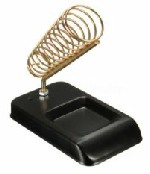
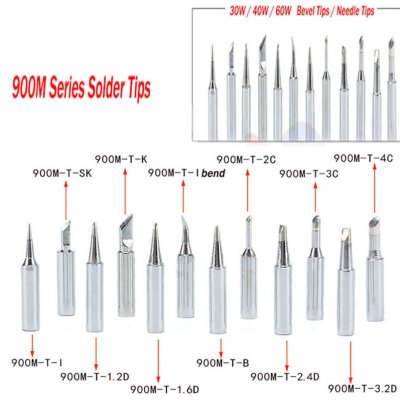
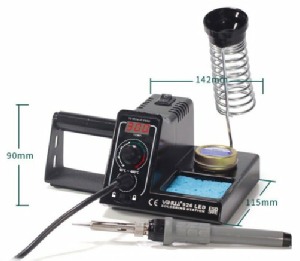
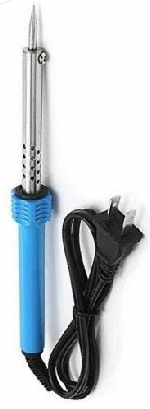
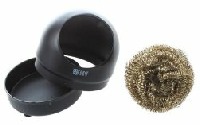
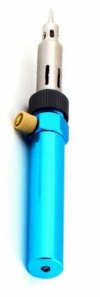

Soldering stand
Metal tip cleaner
Example of Soldering tip types
100W Soldering Iron (fixed)
60W Soldering Iron (Magnestat)
50W Soldering Station (Vari-temp)
25W Soldering Iron (fixed)
Gas Soldering Iron (vari-power)
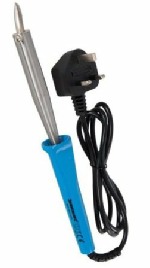
PTC = Positive Temperature Coefficient
Thermocouple = Two dissimilar metals junction
ESD = Electro Static Discharge
Everyone recommends using non corrosive flux (not the plumbers stuff), especially for electronics and electrics and good results can be had, as long as the two substrates are cleaned immaculately beforehand (a glass fibre pen is invaluable) but sometimes (really dirty complicated parts that are hard to clean) demand the acid based stuff, it's not a problem if you can immerse/clean thoroughly afterwards, best to use a slightly alkaline solution to deactivate, it then rinse thoroughly with water.
Check out YouTube for many Tutorials on ‘HOW TO SOLDER’
I would recommend this one
For the ultimate soldering guide, if you have a few hours, for the techy amongst you Circuit Technology Center